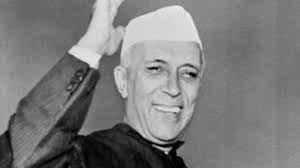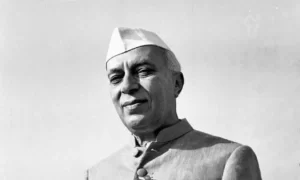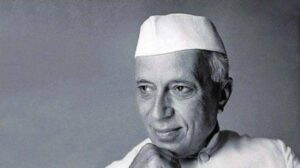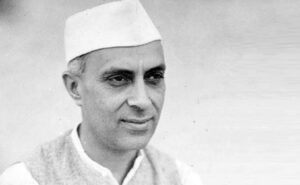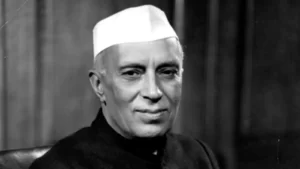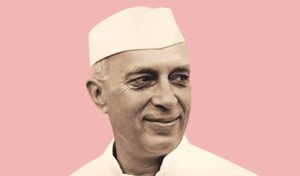Between A Curve & A Tangent
Life is a curve-it is not a straight line-and the life of a nation is even more of a curve. Logical and straight lines are tangents which go off the curve and if the tangent is too far away from the curve of a nation’s life, then there is conflict and upheaval.
Life is anyhow a complex affair, and the conflicts and contradictions of life sometimes make one despair a little. It is not surprising that people should differ, or even that comrades with a common approach to problems should draw different conclusions. But, a person who tries to hide his own weakness in high-sounding phrases and noble principles is apt to be suspect.
In the India of today, the growth of cities, big and small ones, is quite anarchic. It is ugly, it is horrible, in fact, it is painful to see it. I am surprised how it is tolerated by great corporations and city municipalities.
You see… there are concentric circles of action; there are the masses of India; vast masses. And, it may seem odd, but I feel most comfortable in dealing with them directly. I am fairly frank with them. With a large crowd I speak my intimate thoughts always more than in a small committee. I feel I have a desire to be frank with them; because they are frank with me. I have a sense of communion with them, although I am very different from them. But then, there are large committees….There is, say, the Congress, where thousands attend: then a Committee of five hundred: then, this Cabinet of fifteen-so, all these concentric circles try to co-operate with each other. yet all pulling in different directions.
I may be very popular. It is true. But I cannot function as an individual. I have to function through colleagues, through others; I have to carry them with me, or to be carried by them. You see… there are so many forces conditioning and limiting one’s activity.
For a sense of values lies at the very basis of life and governs it. All culture is after all a sense of values, certain restraints, certain responsibilities joyfully undertaken.
A society which ceases to go ahead necessarily becomes weak. This weakness shows itself in all forms of creative activity.
Culture & Diversities
What is culture?
I look it up in the dictionary and I find a variety of definitions. One great writer has called it “the acquainting ourselves with the best that has been known and said in the world.” Another definition. says that it is “the training, development or strengthening of the powers, mental or physical, or the condition thus produced; improvement or refinement of mind, morals, or tastes: enlightenment of civilization.” Culture, in this sense, is something basic and international. Then there are the national aspects of culture and there can be no doubt that many nations have each developed a certain genius and individuality.
Culture and civilization are difficult to define, and I shall not try to define them. But among the many things that culture includes are certainly restraint over oneself and consideration for others. If a person had not got this self-restraint and has no consideration for others, one can certainly say that he is uncultured.
The life of a nation, and more especially of a nation like India, is lived principally in the villages. Nevertheless, it is the cities that represent the highest cultural achievements of the age, as they also do sometimes the more unpleasant aspects of human life. So these I cities remind me of the cultural growth of India, of that inner strength and balance which come from long ages of civilization and culture. We have been very proud of this inheritance of ours in India and rightly so. And yet where do we stand today?
Of course, the basis of Indian culture remains unchanged even though it has absorbed other cultures. Such was the country of our distant ancestors. Gradually, a change came. We became afraid of others and shrank into ourselves. We did not want either to go out ourselves or to let others come in. We developed narrow grooves of thought and narrow divisions amongst ourselves, each division isolating itself from other castes or groups. The capacity to absorb. these various streams of culture is a part of the creativeness of India. Therefore, there is no reason why we should adopt the narrow outlook of pride and folly which makes us think that we have everything and that we need receive nothing from outside.
We have vast areas in India which differ from one another. We have a large number of people whom we call ‘tribal’ people. Many possibly think that tribal people’ means some kind of primitive people. Well, some tribes are rather primitive, but others are highly developed. They have a different kind of society; they do not have a market economy and do not possess many things that come with the machine age. If I may say so, in many ways, they are far better as human beings than non-tribal people like me. They are fine men and women, and possess many cultural qualities which we do not possess.
I have sought… to understand the problems of India, not only through data and statistics, and reports official or non-official, but I have tried to understand them through the Indian people. I have tried to understand them by looking at millions and millions of the eyes of the people of India and their faces, trying to probe into those eyes and have some glimpse of what they have behind them, and it has sometimes helped me to gain that emotional awareness and perhaps brought me nearer to the people of India and brought them nearer to me. And so I wander about not only physically but in my mind over this vast tract of India with its innumerable people, with their basic unity and infinite diversity and try to understand their problems…..
So, you see in India a mixture of the tenth, the fifteenth and the twentieth centuries.
We in India live in a very mixed society–mixed in terms of development, in terms of human beings, in terms of the variety in the country and the people. You will find that many people still live as their forefathers lived a thousand years ago or more. You will also find here people who may be said to live in the middle of the twentieth century.
To be dynamic and creative is the practical policy or the higher view of culture. It is fatal to sink into narrowness of mind in spite of the fact that India has had a tremendously rich inheritance.
Personally, I should imagine that any proper teaching of history would include the artistic and cultural development of a people as an essential element. Without that, history becomes. string of events, of battle and of kings, which can neither inspire nor do much good to anybody.
I realised that science was not only a pleasant diversion and abstraction, but was of the very texture of life, without which our modern world would vanish away…. It was Science alone that solves the problems of hunger and poverty. of insanitation and illiteracy, of superstition and deadening customs and tradition, of vast resources running to waste. of a rich country inhabitated by starving people.
You should not accept or tolerate ugliness anywhere, in your life, in your activities, in your buildings..
The worst type of ugliness of course is ugly behaviour of individuals and groups. But to some extent, the environment reflects itself in the behaviour of the individual, as a beautiful environment helps in developing a sense of beauty in the people who live there. It is desirable, therefore, that what we build, however simple and humble it may be, should have some artistic value. And mind you, do not connect artistic values with money.
Shelter
To provide the good life to four hundred million people of India and more is a vast undertaking, and the achievement of this goal is far off. But no lesser goal can be kept in view, because each present step has to be conditioned by the final objective. Behind the plans that are drawn up is the vision of the future, even as the Indian people had a vision of freedom and independence during the long years of their national struggle, and there is faith and confidence in that future.
I should like to draw your attention to the tremendous housing difficulties in the great cities. Something has to be done about this as its becoming impossible for the average middle class person to get any accommodation. The most fantastic premia and pagris are charged which only the rich can afford. If the existing law is not enough to control the situation, something else has to be done.
I think that housing must be given a high priority. We might not be able to change the face of India quickly, but we should proceed about it with some speed. I think that our normal approach to this has been wholly unsatisfactory.
I am afraid that we have been very slow in the construction of new houses all over India in spite of a great demand for them. Of course, this is largely due to lack of material. Nevertheless, we could have done much even with the existing material, and I have seen many types of model houses built with existing material which are very good. I suggest that each province should not wait for steel and cement all the time but should go ahead with such material as it possesses.
I cannot see why so much stress is laid on the long life of a building when the building consists of bare walls and little else. We have to think out this problem afresh and take urgent steps. Private and vested interests must on no account come in the way of this housing reform.
Although essential houses are not being built are being built very slowly, luxury buildings still continue to be put up, such as cinemas, large bungalows, large shops, etc. I think the time has come when such luxury construction should be prohibited.
I came here this morning after visiting a large colony which is growing up near Delhi. It happens to consist of residential houses and Government offices entirely constructed of pre-fabricated mate rial from the Delhi Housing Factory. They are considerably cheaper and swifter to build than the other houses. I believe some schools in Delhi are being made of pre-fabricated material? So, that is a matter which requires consideration because our housing program mes have become bigger and bigger not only for schools but for everything. It is very difficult to keep pace with them unless you adopt some methods like these, like having pre-fabricated materials. production of which will both be cheaper and speedier.
I have little doubt in my mind that we shall have to go in for pre fabricated houses on a large scale, if we are to meet the housing shortage. These houses must be built very largely with such material as may be locally available. This will not do away with the traditional methods of building. There is plenty of scope for both.
Wherever I go now. I am interested in the housing problem. I feel more and more not only the urgency of this but that we have perhaps not thought of it on the right lines. We considered it always in terms of brick and mortar, cement and solid buildings which are costly. Because of the large finances involved, we cannot undertake it on any big scale. A different approach might well reduce the cost greatly, give far-reaching results, and perhaps produce houses which are more suited to our climate and customs.
Houses suitable for the villages should be so designed that they can be built with local material. This will not be difficult, and it is being done in some places. You can’t have any great housing programme for villages with imported material. But the planning of the houses and that of the villages can be given some thought, keeping always in view that the population is increasingly impinging on other villages and towns and cities.
Poverty
We are struggling to get out of the morass of poverty, and to reach the stage of what is called “the take-off into sustained economic growth. We want to cross the barrier of poverty and reach the stage where growth becomes relatively spontaneous
The underdeveloped country is on this side of the barrier. There are certain cumulative processes at work which, in a developed country. tend to encourage its growth further and further and which, in an under-developed country pull it back all the time. The poor becomes poorer.
The person who is poor cannot, because he is poor, work hard and efficiently and therefore his capacity to work becomes less and less. Poverty pulls him back and he does not make progress. On the other hand, the person who enjoys good health, good education and good surroundings increases his capacity for work and produces more and more. The result is so far as normal economic forces at work are concerned, they tend constantly to widen the gap between the well-to-do and those who are not well-to-do. This applies to countries as to individuals. The blind forces of the market are always widening the gap. whether they operate internationally or nationally or regionally.
Poverty becomes it own curse. Under-development repeats itself.
Yet India with all her poverty and degradation had enough of nobility and greatness about her, and though she was overburdened with ancient tradition and present misery, and her eyelids were a little weary, she had “a beauty wrought out from within upon the flesh, the deposit little cell by cell. or strange thoughts and fantastic reveries and exquisite passions.”. Behind and within her battered body one could still glimpse a majesty of soul. Through long ages she had travelled and gathered much wisdom on the way, and trafficked with strangers and added them to her own big family, and witnessed days of glory and of decay, and suffered humiliation and terrible sorrow, and seen many a strange sight; but throughout her long journey she had clung to her immemorial culture, drawn strength and vitality from it, and shared it with other lands. Like a pendulum she had swung up and down; she had ventured with the daring of her thought to reach up to the heavens and unravel their mystery, and she had also had bitter experience of the pit of hell.
Poverty is not a good thing; it is not to be exalted or praised, but an evil thing which must be fought and stamped out.
The more immediate problem is to combat the curse of poverty. with all the ills that it produces, and it is recognised that this can only be done by social and economic advance, so as to build up a technologically mature society and a social order which offers equal opportunities to all citizens. This involves basic social and economic changes and the replacing of the old traditional order by a dynamic society. It involves not only the acceptance of the temper and application of science and modern technology, but also far-reaching changes in social customs and institutions.
Private enterprise is a good thing. But private enterprise as it was known in the nineteenth century is dead or ought to be dead. It is not a question of the merit or demerit of an individual. We have to take note of the spirit of the age. We have to face the particular .problem of breaking through those tendencies which make a poor country poorer. If left to normal forces under the capitalist system. there is no doubt at all that the poor will get poorer and a handful of the rich richer.
In India we have a terrible problem of extreme poverty in certain large regions, apart from the general poverty of the country we have always a difficult choice before us: whether to concentrate on production by itself in selected and favourable areas, thus for the moment rather ignoring the poor areas, or try to develop the backward areas at the same time so as to lesson the inequalities between regions. A balance has to be struck and an integrated national plan evolved….
Slums
All of us, no doubt, feel the necessity for better housing for our workers and others and yet I have a sensation that we do not feel this quite as acutely as we ought to feel. There is no sense of horror and urgency about it. If we have an epidemic of plague, we shake ourselves up and try to suppress it with all our might. These slum dwellings are as bad as an epidemic and for us to tolerate them, even though we dislike them, means a certain complacency, a certain acceptance of things as they are, even though they are very bad.
Slums are a disease, which if not checked immediately, might well overshadow the beauty of Bangalore. There is no reason why slums should be allowed to grow.
I believe in no argument, economic or other, which is based, on the creation of slums. I have a horror of slums. I don’t mind a person living in the open like a vagabond or a gipsy. I am a bit of a vagabond myself, and I like vagabonds and gipsies. I don’t mind a person living in a mud hut. But I do mind slums in cities, and I have often said if you cannot provide buildings for those dwelling in slums, give them an open space to live in, and give them at least some social services, like good sanitation and water supply. The rest will follow.
It is bad enough to inherit slums. But to allow them to grow is your own fault and your city’s fault and your population’s fault and your Government fault and our fault. They should not be allowed to grow, I believe in no industrial development which comes at the cost of slums.
Light and air are more important than a brick house. Nothing could be worse than the slums that have grown up in some of our cities. including Delhi, even though those slums consist of solid buildings.
No city or community can progress if it has black, insanitary hovels and starving people within its orbit.
Art, Architecture, Archaeology
I have accepted with pleasure the task of inaugurating the National Art Treasures Fund, not because I happen to be a particularly suitable person in matters connected with art but because I greatly admire it, albeit as an inexpert layman. I consider it very important that the artistic and aesthetic side of a nation’s growth be given prominence.
You may have noticed that in February last I inaugurated what is called the National Art Treasures Fund, with the object of acquiring and preserving for the nation art objects of national importance which are in danger of neglect, deterioration or total loss. This is important. It is a duty that we owe not only to ourselves but to future generations. I am afraid that most of us, immersed as we are in our political problems, forget the basic importance of culture and art. We have not even got a proper National Museum in Delhi, although we have got a fine collection in Rashtrapati Bhavan. If this National Art Treasures Fund is to succeed, we must have popular interest and support and money for it.
Therefore, I greatly welcome the creation of this Fund in the hope that it will lead to the creation of that atmosphere even in this official ridden city of New Delhi as also in the other great cities of India. I should like the whole country to be dotted with museums, They cannot all be very big: you cannot spread out the treasures all over the country. They have to remain more or less concentrated to be properly looked after. They can be duplicated to some extent at other places, too. What I am anxious about is this; every child in India should see something of these artistic treasures, should understand something that has gone to build up India, should assimilate, even if in a small measure, the genius India, which, adapted to the modern conditions, should make the country grow.
I think that the step which has been proposed is an important one in this direction, because art, like some other things, should not become just a governmental affair and should not depend entirely on the encouragement of the government. Governments should, of course, encourage it but governments have a peculiar way of working and they somehow become rigid and lose touch with the popular mind.
The whole idea of museums somehow seems to be unconnected with the life of our people. It lives in the upper atmosphere officials. That is not good enough and the question arises how we can make museums a vital part of our people’s lives, of the lives of our school children and of college boys and girls who can come and see and learn from them and be inspired by objects of art and thus develop their own creative talents by looking at the great creations of the past.
Art galleries and museums in a great city are like windows which look out on the broader, richer and deeper things of life. I feel somewhat ashamed that in this great capital of India we have nothing really worthy of being called a museum.
So, it is important to have museums, not only to keep treasures intact and make them accessible but also to enable the rising generations to look at them, so that they can have some idea. Delhi has got no proper museum. We have some small collections here that are good but they are practically nothing compared with the great museums of Europe and America. And that is unfortunate for all of us, more especially for our children who receive their idea of beauty or lack of beauty from such institutions. If I may say so with all respect, the governmental structures of Delhi are not all very beautiful to look at, although some of them are obviously meant to impress. If you want to see architectural beauty in India, you have to go back to the buildings of another age.
No country and no people can subsist only on primary needs; they certainly cannot grow. Apart from food, one has also to provide them with other fare — clothing and other necessities of life.
After all, when we talk of the growth of a people, of civilization, of cultural life, we think of all manner of things, besides these. primary needs. We think of their mental, intellectual and spiritual growth and of the artistic and aesthetic needs of their lives.
It does not really matter very much whether you remember the names of kings or not but it is important that you remember the artiste achievements of a race.
Architecture to a large extent is a product of the age. It cannot isolate itself from the social conditions, the thinking and the objectives and the ideals of the age to which it belongs. Mr. Humayun Kabir referred to the static condition in regard to architecture in India in the last 200 or 300 years. That really was a reflection of the static condition of the Indian mind or Indian conditions. In fact, India has been static, architecturally considered, for the last few hundred years. The great buildings which we admire date back to an earlier period. We were static even before the British came. In fact the British came because we were static.
The purpose which a building serves depends to a large extent on the functions which a society performs. There is often a lag between architectural designs, or indeed, the social frame work and the changes taking place in the technological field.
In the early years of the industrial revolution when the steam engine and the railways came and when railway stations had to be built, the architects tried to make some of the big railway stations – look as if they were Gothic cathedrals. They were not able to get out of the clutches of the past.
The architect is obviously limited by his material. If technology gives us more materials and more power to mould those materials, new avenues open up for using them. Today, I believe very good work is being done all over the world by creative architects. It is a delight to see plans and designs and pictures of this new work being done.
We should not be afraid of innovations.
The past was good but only when it was the present,
We cannot bring it forward and put up a Gothic cathedral and call it a railway terminus. I give this example because there is a tendency to do this kind of thing.
Therein comes the role of the so-called organized authority, whether it is Government or Corporation or Municipality or Panchayat, or whatever it is. In order to do that, we constitute this organized authority from those elected by the people. It casts responsibility on the people. That is the democratic method.
Our old architecture was magnificent and was, perhaps, among the greatest architectures of the world. See, how it became degraded. It still retained its craftsmanship but the nobility of design that had come from simplicity was gone. It became heavier and heavier. There was no dignity in it, only hard work.
One often sees in India, recently erected, horrible buildings, big buildings, costly buildings, painful to look at. It is not a question of money, but a sense of artistry.
In this highly utilitarian age, how does one justify archaeology? I have no clear answer to that except that I am quite sure it is very important. There are things of the highest value, like art and goodness, which are far more important than many utilitarian objects that we have.
In a country like India there are many number of places which deserve careful working out from the archacological point of view. And yet I think how much destruction there has been in India of archaeological sites either deliberately or through carelessness. I remember when I first heard of Mohenjodaro how tremendously excited I felt, as when I first read of the Indians who went out of India in the early years of the Christian era to South-East Asia and put up great buildings there which even today are among the famous monuments of the World.
Some years ago a matter of conscience arose for us when we were considering what we should do about Nagarjunakonda in the South. There was this buried city gradually coming out, and there was the proposal to erect a dam there and create a big reservoir which would supply water for irrigation. There was a direct conflict between the claims of today in the sense of practical utility and the claims of the past. We were troubled by the conflict. But it was inevitable that we should decide ultimately in favour of present. And that turned out to be the best way of preserving the past also. The old relics of Nagarjunakonda were rapidly crumbling into dust and ashes, and we decided that they should be removed bodily and placed on a little island in the middle of the lake and preserved in such a way as to prevent their decay.
It is a delight to see plans and designs and pictures of this new work being done by architects all over the world.
Bhakra-Nangal is a tremendous affair. The very size of it is impressive and to dare to take up such huge undertakings is by itself in favour of our country. It shows confidence in oneself and in our future.
Quality of Man
It is often said that there is a sense of frustration and depression in India and the old buoyancy of spirit is not to be found at a time when enthusiasm and hard work are most needed. This is not in evidence merely in our country. It is in a sense a world phenomenon. An old and valued colleague said that this is due to our not having a philosophy of life, and indeed the world also is suffering from this lack of a philosophical approach.
In our efforts to ensure the material prosperity of the country we have not paid any attention to the spiritual element in human nature. Therefore in order to give the individual and the nation a sense of purpose, something to live for and if necessary to die for, we have to revive some philosophy of life and give, in the wider sense of the world, a spiritual background to our thinking.
Obviously, everybody will agree, almost everybody, that we have to provide a good life to all our citizens. We may argue about what a good life is. But essentially a good life means certain basic material things that everybody should have, like enough food and clothing, a house to live in, education, health services and work. These are the natural things that everyone should have.
Life does not give its gifts over and over again, and we kick away its valuable gifts at some peril to our future.
Ultimately its success depends upon the quality of the men. If that quality is bad, the best of methods will fail. If it is good, it will succeed wonderfully. That is how we try to create conditions for good civilized living At present. those conditions are totally lacking. Oddly enough, we see the lack of civilized living at both ends of the social scale.
A human being grows and ought to grow like a flower or a plant. You can water it, you can help it grow; you can give it good soil; you can put it in the fresh air or in the sun. But it has to grow itself, you cannot make it grow by force.
Greatness comes from vision, tolerance of spirit, compassion and an even temper, which is not ruffled by ill-fortune or good fortune alike..
Life has to be seen as a whole, as an integrated whole.
We mean a society in which there is equality of opportunity and the possibility for everyone to live a good life. Obviously, this cannot be attained unless we produce the wherewithal to have the standards that a good life implies. We have. therefore, to lay great stress on equality, on the removal of disparities, and it has to be remembered always that socialism is not the spreading out of poverty. The essential thing is that there must be wealth and production.
The real capital we have is our intellectual and other capacity for work and that no one can take from us.
Money is important, but human beings are much more important.
It is clear that in the final analysis it is the quality of the human beings that counts. It is man who builds up the wealth of a nation as well as its cultural progress. Hence education and health are of high importance so as to produce that quality in the human beings. We have to suffer here also from the lack of resources, but still we have to remember always that it is right education and good health that will lay the foundation for economic as well as cultural and spiritual progress.
Although our schools may not be very wonderful to look at.. although our teachers may not be perfect, the mere fact that 55 million boys and girls go to school is a tremendous development. It is a revolutionary development, and this fact is changing the whole structure of our society. The children who go to school, specially the girls, influence their parents who may be illiterate, and many of whom live in the villages. Their mothers, grandmothers and earlier to them many generations have never been to school. When the children start going to school, they learn new things and tell their parents about them. They introduce little changes in their homes. There is now a very large number of young women going to our colleges.
Then the question arises as to what our ultimate objective should be. Democracy and socialism are means to an end, not the end itself. We talk of the good of society. Is this something apart from and transcending the good of the individuals composing it? If the individual is ignored and sacrificed for what is considered the good of the society, is that the right objective to have?
There is only one thing that remains to us that cannot be taken away: to act with courage and dignity and to stick to the ideals that have given meaning to life…
Though we may be weak and erring mortals, living a brief and uncertain span of life, yet there is something of the stuff of the immortal Gods in us.
Danger can be discussed and overcome, prestige cannot.
We are in process of publishing more parts. Follow us on Social Media to keep yourself updated:


